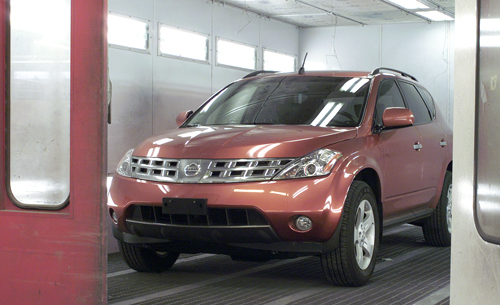Auto Technical Reference Library |
Topic
Index |
A spray booth is designed to isolate the spraying environment from the shop area. Having this type of spray environment helps keep dust, dirt and any other contaminants out of the painting surface. This will reduce or eliminate the need for sanding and buffing. A spray booth also confines hazardous paint fumes. Current designs have their own air makeup system providing even temperatures and clean filtered air, to assure proper booth performance.
Spray booths are designed to comply with federal, state and local safety codes. In some areas, sprinkler systems are required inside the booth because of the highly explosive nature of refinishing materials and the temperatures reached during baking.
Crossdraft Spray Booth
Moves air front to rear going from one end of the vehicle to the other. An air inlet at one end of the booth with filters allows fresh air into the booth. At the other end is an exhaust fan with filters to remove air and overspray. Some booths use shop air by pulling it through the inlet filters. These filters are usually placed in openings of the booth doors where the vehicles enter and exit.
Downdraft Spray Booth
The most popular booth in use today, containing its own air makeup system forcing air through two sets of filters through the ceiling. The air or overspray is then exhausted through the floor and through another set of filters. This downdraft air movement prevents contamination and overspray from settling on the freshly painted surface of the vehicle. Consideration for waterborne paints is increased air flow which causes dehydration to cure the base coat. After the spraying process, most downdraft booths have a cure or bake cycle which is required for the solvent based clear coat. They can go from 70°F to 160°F in 5 to 7 minutes. Some booths come equipped with infrared drying equipment. Special considerations must be taken when painting hybrid vehicles as to not damage the HV battery. Always follow the manufacturers recommendations.

Traditional downdraft spray booth

Waterborne designed downdraft spray booth
(Notice the adjustable air nozzles located in the back corners)
One Room Booth
This booth has all the same characteristics of a downdraft booth. After a vehicle is painted, the technician converts the booth from the paint cycle to the cure cycle. The curing process can take ten to forty minutes depending on the size of the job and the additives used.
Two Room Booth
A spray booth that has a separate curing room that is attached at one end. This booth has doors that open in the front allowing the vehicle to enter the spray booth. After the vehicle is sprayed it is then passed through doors dividing the two rooms and enters the curing room. The curing room is put through the cure cycle allowing another vehicle to be painted in the spray room. After the vehicles cure, they exit out the curing room door, creating a consistent work flow.